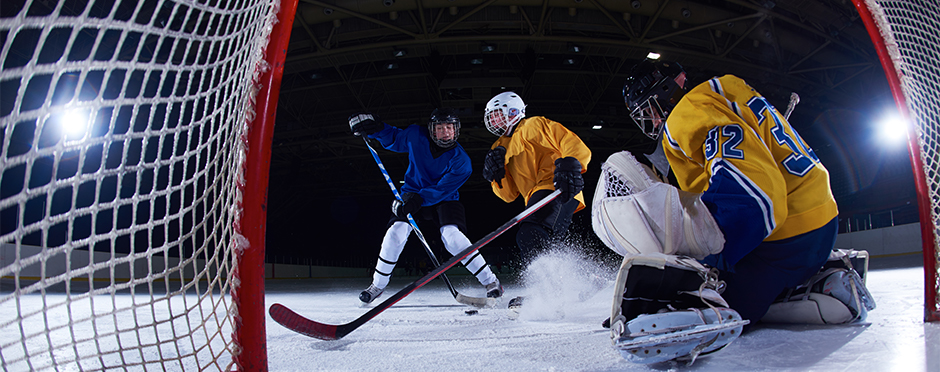
Common Hip and Groin Injuries in Hockey
1 CommentHip and groin injuries are some of the most common injuries in hockey due to the mechanics of the skating stride and goalie positioning. They are frequently responsible for time lost from play or a decline in performance. In order to minimize the risk of hip and groin injuries, it is important to address hip and core muscle restrictions, imbalances, and stability impairments.
Let’s start with a quick overview of common hip and groin injuries facing hockey players:
Muscle strains, sprains, tendonitis and bursitis of the hip flexors, groin, and adductors: Soft tissue injuries like these can be divided into acute injuries (which occur in the moment, such as a fall or twisting motion) or overuse injuries (occurring gradually over time due to repeated stress). Overuse injuries in hockey typically occur due to the repetitive motion of the skating stride, goalie mechanics such as the butterfly position, and the quick bursts of energy required for hockey. These injuries often lead to pain with the skating stride, quick direction changes, and lateral movement and positioning required for goalies. Symptoms typically include pain in the hip or groin with skating, running, quick direction changes and squatting, but can vary based on the location of the injury. These injuries do not always lead to missed time from play, but if not managed properly can impact performance and lead to further injury.
Hip Femoracetabular Impingement and Labrum Tears: Unlike the muscle and tendon issues discussed above, these injuries include damage to the joint alignment and the labrum. The labrum is the cartilage that lines the inside of the hip joint and functions to increase joint stability and protect the hip joint. The repetitive movements and extreme range of motion required in hockey increases risk of labral tears. Femoroacetabular impingement (FAI), which occurs when extra bone grows along the hip joint, is another common source of labral tears. The irregular bone shape associated with FAI leads to excess rubbing and pinching of the joint, and is typically worsened by hockey specific movements. Symptoms of labral tears and FAI frequently include pain in the groin that worsens with activity, painful catching and locking of the hip, and discomfort with sitting and squatting.
Studies show that hip injuries in hockey players can be prevented by proper strengthening. In fact, an improper hip strength ratio leads to players being 17x more likely to sustain a hip injury.1 When hip strengthening, it is essential to restore the balance between the hip abductors (outer hip muscles) and hip adductors (inner hip muscles). It is also important to strengthen the hamstrings and core since they help stabilize the knee and body during the weight shift and push off of the skating thrust.
Below are some suggestions of hip strengthening exercises that can help prevent injury and improve on ice performance.
1. Band Walks
Tie a band around your ankles. Take 10 steps to the side keeping your toes pointed forward, return the other way. You should feel a burn in the outer hips. Perform two times.
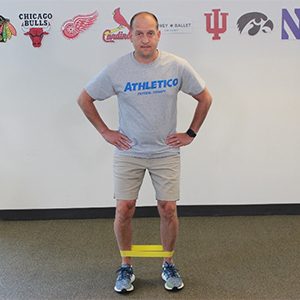
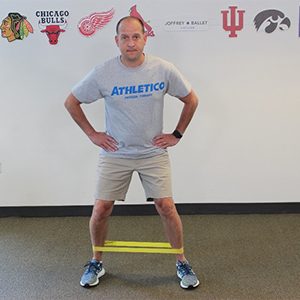
2. Monster Walks (Forward and Backward)
Tie a band around your ankles. Take 10 steps in a forward diagonal direction. Return by walking backward in a backward diagonal direction. Perform two times.
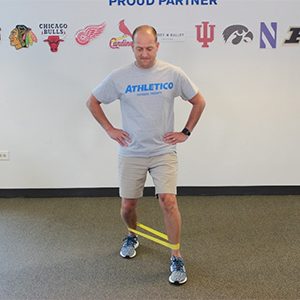
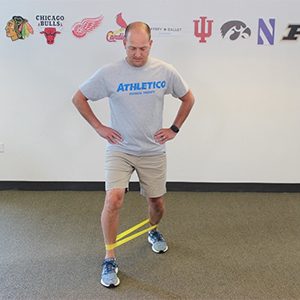
3. Side Lunges
Stand with a small space between your feet. Next, step to the side and bend that knee into a lunge position. As the knee bends, lower you bottom down toward the floor. Keep knees in line with your toes. Perform 10 reps, three times on each side. Focus on a slow, and controlled lower body.
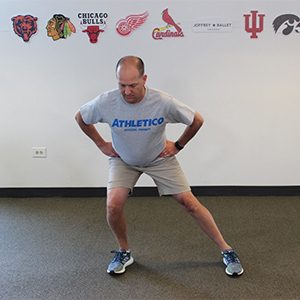

4. Side Planks
While laying on your side, rest your elbow on the floor and lift your body up off the ground. Hold for 30-60 seconds, and perform three times on each side.
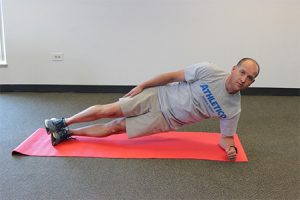
If you have further questions on hip injuries, strengthening or rehabilitation, please click the button below to schedule an appointment with one of our experts. To learn about Athletico’s Sports Edge Hockey Assessments, please contact our Lincoln Square clinic at LincolnSquare@athletico.com. These assessments thoroughly evaluate the strength, mobility and hockey-specific movements required to stay injury free and return to a higher level of performance following injury.
The Athletico blog is an educational resource written by Athletico employees. Athletico bloggers are licensed professionals who abide by the code of ethics outlined by their respective professional associations. The content published in blog posts represents the opinion of the individual author based on their expertise and experience. The content provided in this blog is for informational purposes only, does not constitute medical advice and should not be relied on for making personal health decisions.
References:
1. Tyler, Timothy F., et al. “The Association of Hip Strength and Flexibility with the Incidence of Adductor Muscle Strains in Professional Ice Hockey Players.” The American Journal of Sports Medicine, vol. 29, no. 2, 2001, pp. 124–128., doi:10.1177/03635465010290020301.

1 Comment
Lita Thau
Very informative. I know many
people who share these injuries
Will pass this on. Thank you